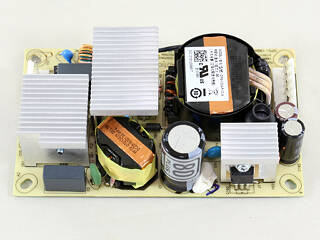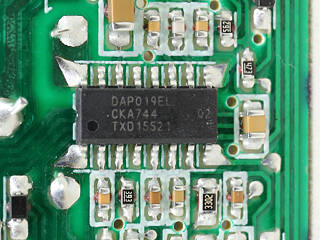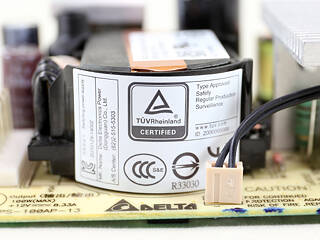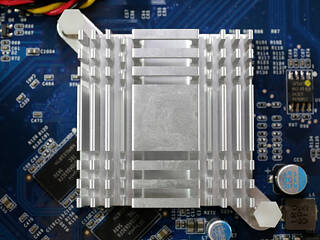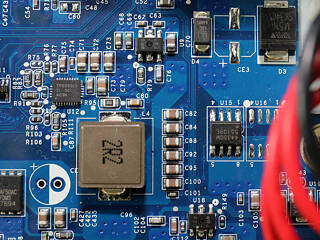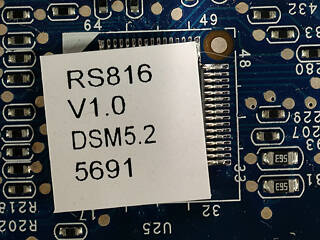 5
5
Synology RackStation RS816 4-Bay NAS Review
Initial Setup and Web Interface »A Look Inside
Once we removed the top cover, which was easily done since we only had to deal with four screws, our eyes focused immediately on the open-frame PSU. Since height is limited, a very small PSU had to be used.
| Delta DPS-100AP Parts Description | |
|---|---|
| General Data | |
| Manufacturer (OEM) | Delta Electronics |
| Platform Model | DPS-100AP-13A |
| Primary Side | |
| Transient Filter | 4x Y caps, 1x X caps, 2x CM chokes, 4x GTD (Gas Discharge Tubes) |
| Bridge Rectifier(s) | 1x GBU408 (800V, 4A @ 100°C) |
| Inrush Current Protection | NTC Thermistor |
| APFC Mosfets | 1x Infineon SPA11N80C3 (800V, 7.1A @ 100°C, 0.45Ω @ 25°C) |
| APFC Boost Diode | 1x |
| Hold-up Cap(s) | 1x Rubycon (420V, 100uF, 105°C, BXA series, 12000h @ 105°C). |
| Main Switchers | 1x Infineon SPA11N80C3 (800V, 7.1A @ 100°C, 0.45Ω @ 25°C) |
| Combo APFC/PWM Controller | On Semiconductor DAP019A |
| Secondary Side | |
| +12V | 2x STMicroelectronics STPS40M80CT (80V, 40A @ 150°C) |
| Filtering Capacitors | Electrolytics: Rubycon (105°C, ZLK series, 5000h lifetime), Chemi-Con (105°C, KZM series, 6000h-10,000h lifetime) |
| Supervisor IC | On Semiconductor DAP019A |
| Fan Model | - |
The DPS-100AP is a PSU of incredible quality, capable of delivering 100 W at up to 50 °C ambient. Even some very expensive ATX PSUs aren't capable of doing so and are restricted to 40 °C for full power delivery instead.
The transient/EMI filter would be complete with an additional X capacitor, and although it doesn't feature an MOV, we spotted four parts which look to be gas discharge tubes. These have the same functionality as MOVs, but the latter are to be preferred in PSUs.
An NTC thermistor offers protection against large inrush currents. There is no bypass relay for it, and to be frank, we didn't expect one in such a small PSU.
The PSU's bulk cap will last for ages since there are normally 2,000h caps in this stage (APFC converter). Because of the PSU's low capacity, a single APFC FET and primary switcher are enough to cope with the task. The single bridge rectifier is also strong enough to meet the unit's demands, even with 115 V input.
The combo PFC/PWM controller is an DAP019A IC; it is apparently custom made for DELTA, which is also why there is very little information available about its specs and features. It looks as though it supports OTP (Over Temperature Protection) and all other necessary protections, which has it act as a supervisor IC and perform PFC/PWM duties.
The main transformer is quite large for the PSU's low capacity.
In the secondary side, a limited number of high quality caps filter the +12V rail generated by two STMicroelectronics SBRs (Schottky Barrier Diodes). Since this PSU is only 80 PLUS Silver rated, there is no need for a synchronous design in the secondary side.
Soldering quality is very good, something we have come to expect of Delta's implementations.
Now that we have analyzed the server's power supply, it is time to take a look at the parts housed on the system's mainboard.
The LED board at the front is connected to the mainboard through a ribbon cable.
There is no need for active cooling because of the Marvell Armada 385 88F6820's low 5W TDP. The system's RAM is soldered to the mainboard, which makes upgrading it impossible. The RAM modules are by SK Hynix, and their model number is H5TQ4G63CFR. Each of these has a capacity of 512 KB, which makes for a total of 1 GB.
One of the voltage regulator modules on the mainboard is controlled by a RichTech RT9199. We also found a synchronous buck converter on the mainboard, a TPS53515.
An Altera 5M80Z Complex Programmable Logic Device, or CPLD for short, stores the server's configuration.
The BIOS battery and system's speaker are installed close to each other.
We spotted a PIC16F1829 8-bit micro controller on the mainboard.
Two Marvell Alaska 88E1514 Ethernet controllers take care of the Ethernet ports.
Here's a voltage regulation module that uses a Texas Instruments TPS535151 step-down (buck) converter.
The trio of fans is by Sunon. Their model number is MB40201V2 (40 mm, 12 V, 0.6 W, 6200 RPM, 7.7 CFM, vapor bearing).
Jul 13th, 2025 04:51 CDT
change timezone
Latest GPU Drivers
New Forum Posts
- No offense, here are some things that bother me about your understanding of fans. (74)
- Archival HDD constantly starting up for no reason (2)
- The Filthy, Rotten, Nasty, Helpdesk-Nightmare picture clubhouse (2723)
- Is RX 9070 VRAM temperature regular value or hotspot? (403)
- Best motherboards for XP gaming (121)
- Screen burn-in (35)
- Help with updating firmware on a AOC Agon Pro OLED monitor, says I need Install Tool (9)
- NVIDIA RTX PRO 6000 Workstation Runs Much Hotter Than 5090 FE (23)
- New ToS of Take Two and 2K (13)
- Is there a WIFI chip I should get? (2)
Popular Reviews
- Fractal Design Epoch RGB TG Review
- Lexar NM1090 Pro 4 TB Review
- Corsair FRAME 5000D RS Review
- Our Visit to the Hunter Super Computer
- NVIDIA GeForce RTX 5050 8 GB Review
- NZXT N9 X870E Review
- Sapphire Radeon RX 9060 XT Pulse OC 16 GB Review - An Excellent Choice
- AMD Ryzen 7 9800X3D Review - The Best Gaming Processor
- Upcoming Hardware Launches 2025 (Updated May 2025)
- Chieftec Iceberg 360 Review
TPU on YouTube
Controversial News Posts
- Intel's Core Ultra 7 265K and 265KF CPUs Dip Below $250 (288)
- Some Intel Nova Lake CPUs Rumored to Challenge AMD's 3D V-Cache in Desktop Gaming (140)
- AMD Radeon RX 9070 XT Gains 9% Performance at 1440p with Latest Driver, Beats RTX 5070 Ti (131)
- NVIDIA Launches GeForce RTX 5050 for Desktops and Laptops, Starts at $249 (120)
- NVIDIA GeForce RTX 5080 SUPER Could Feature 24 GB Memory, Increased Power Limits (115)
- Microsoft Partners with AMD for Next-gen Xbox Hardware (105)
- Intel "Nova Lake‑S" Series: Seven SKUs, Up to 52 Cores and 150 W TDP (100)
- NVIDIA DLSS Transformer Cuts VRAM Usage by 20% (97)






